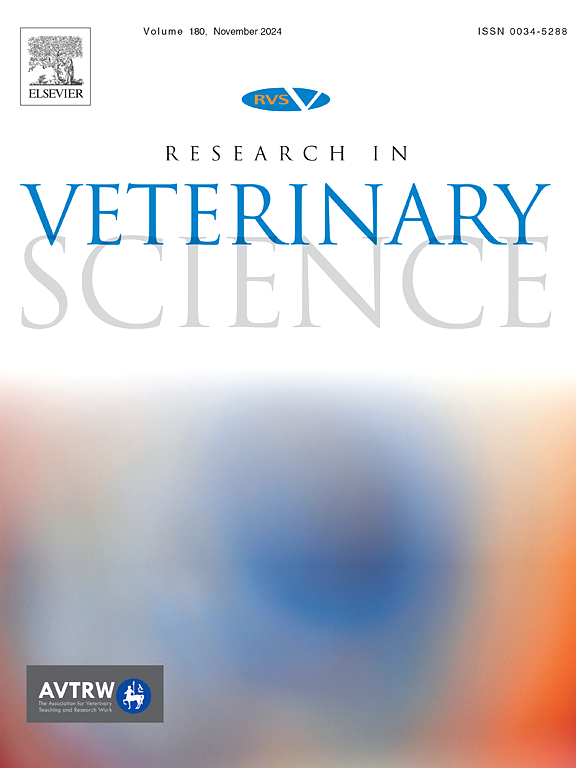Initial psychometric evaluation of the canine brief pain inventory in a Danish sample of dogs with pain related to osteoarthritis
IF 2.2
3区 农林科学
Q1 VETERINARY SCIENCES
引用次数: 0
Abstract
Introduction
Osteoarthritis (OA) is the most diagnosed arthropathy in dogs. Since the characteristic manifestation of OA is pain, clinical metrology instruments for OA should detect observable outcomes related to OA pain and be validated in the translated form. This study aimed to validate a Danish translated version of Canine Brief Pain Inventory (CBPI) in a cohort of dogs diagnosed with OA.
Methods
The CBPI was translated into Danish. Data of clinically healthy dogs were compared with data of dogs with OA, and the translation was analysed for construct validity and internal consistency. Construct validity was tested with an exploratory factor analysis by principal component analysis, while internal consistency was estimated by Cronbach's α coefficient.
Results and conclusions
The Danish version of CBPI was completed by owners of 72 dogs with OA and 21 owners of clinically heathy dogs. Dogs with OA had significantly higher CBPI scores than healthy dogs, demonstrating the Danish CBPI's discriminant ability. An identified two-factor model accounted for 77.7 % of the total variance. Good internal consistency was identified across the instrument with high Cronbach's α levels: 0.95 for the total CBPI, 0.93 for the first factor (items 1–6) and.0.88 for the second factor (items 7–10).
初步心理测量评估犬简短的疼痛清单在丹麦的狗与骨关节炎相关的疼痛样本
骨关节炎(OA)是犬中诊断最多的关节病。由于OA的特征性表现是疼痛,OA的临床计量仪器应该检测到与OA疼痛相关的可观察结果,并以翻译的形式进行验证。本研究旨在验证丹麦语翻译版本的犬短暂疼痛量表(CBPI)在诊断为OA的犬群中的有效性。方法将CBPI翻译成丹麦语。将临床健康犬的数据与OA犬的数据进行比较,并对翻译进行结构效度和内部一致性分析。结构效度采用主成分分析进行探索性因子分析,内部一致性采用Cronbach’s α系数进行评估。结果与结论丹麦版CBPI由72只OA犬的主人和21只临床健康犬的主人完成。骨性关节炎犬的CBPI得分明显高于健康犬,证明了丹麦CBPI的判别能力。一个确定的双因素模型占总方差的77.7%。整个仪器内部一致性良好,Cronbach's α水平高:总CBPI为0.95,第一个因素(项目1-6)为0.93,第二个因素(项目7-10)为0.88。
本文章由计算机程序翻译,如有差异,请以英文原文为准。
求助全文
约1分钟内获得全文
求助全文
来源期刊

Research in veterinary science
农林科学-兽医学
CiteScore
4.40
自引率
4.20%
发文量
312
审稿时长
75 days
期刊介绍:
Research in Veterinary Science is an International multi-disciplinary journal publishing original articles, reviews and short communications of a high scientific and ethical standard in all aspects of veterinary and biomedical research.
The primary aim of the journal is to inform veterinary and biomedical scientists of significant advances in veterinary and related research through prompt publication and dissemination. Secondly, the journal aims to provide a general multi-disciplinary forum for discussion and debate of news and issues concerning veterinary science. Thirdly, to promote the dissemination of knowledge to a broader range of professions, globally.
High quality papers on all species of animals are considered, particularly those considered to be of high scientific importance and originality, and with interdisciplinary interest. The journal encourages papers providing results that have clear implications for understanding disease pathogenesis and for the development of control measures or treatments, as well as those dealing with a comparative biomedical approach, which represents a substantial improvement to animal and human health.
Studies without a robust scientific hypothesis or that are preliminary, or of weak originality, as well as negative results, are not appropriate for the journal. Furthermore, observational approaches, case studies or field reports lacking an advancement in general knowledge do not fall within the scope of the journal.
 求助内容:
求助内容: 应助结果提醒方式:
应助结果提醒方式:


